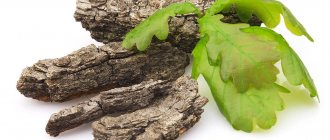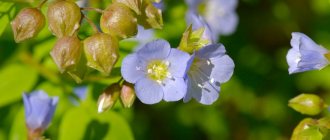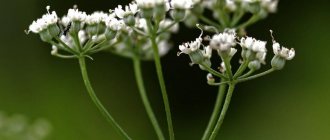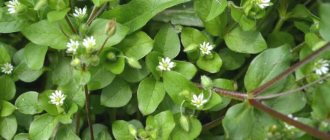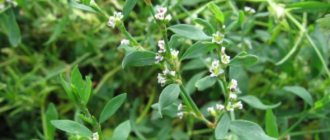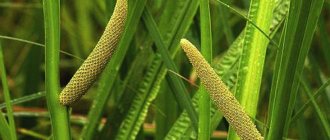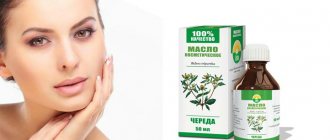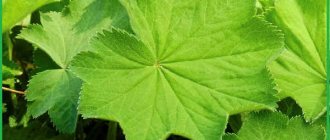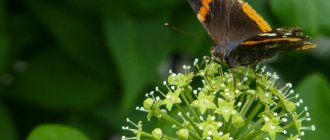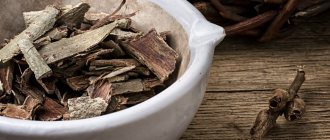Composition and release form
| Liquid | 100 ml |
| juice from biostimulated leaves or “children” of aloe vera | 80 ml |
| ethanol | 20 ml |
in dark glass bottles of 50 ml; 1 bottle in a cardboard pack.
| Syrup | 1000 g |
| freshly prepared 20% solution of ferrous chloride | 135 g |
| food grade citric acid | 4 g |
| diluted hydrochloric acid | 15 g |
| aloe vera syrup | up to 1000 g |
in dark glass bottles of 100 g; 1 bottle in a cardboard pack.
| Liniment | 1 ban. |
| Aloe vera juice | |
| Eucalyptus oil | |
| Castor oil | |
| excipients: emulsifiers |
in dark glass jars of 30 g; in a cardboard pack 1 jar.
| Film-coated tablets | 1 table |
| crushed preserved aloe vera leaf | 0.05 g |
in a blister pack 10 pcs.; 2 packs in a cardboard box.
Features of Aloe Vera
The medicinal properties of aloe vera have been studied the most. It is this type of succulent that is actively used in pharmacology, cosmetology, perfumery, and folk medicine. This particular species is an unpretentious houseplant and at the same time a useful “home healer”.
Origin and range
Aloe is native to North and East Africa. In the wild, this plant is found in Morocco, Mauritania, Egypt, the Arabian Peninsula, as well as in tropical Africa, Madagascar. Aloe is widespread in Asian countries, India, and South America. The island of Socotra is famous for its variety of species of this succulent. Here, by evaporating the juice, the world-famous dry extract of the plant, sabur, is obtained, which can be stored for a long time. In the wild, aloe can withstand arid and hot climates. Some species, such as aloe vera, can reach a height of up to 6 meters. The plant contains a lot of moisture, which it retains by closing the pores on the leaves.
Types of aloe
There are about 500 species of this genus of succulent plants. What medicinal types of aloe can be grown as indoor plants?
- Aloe Barbados, also known as aloe vera, real aloe.
- Aloe variegated.
- Aloe spinosa, or tiger.
- Aloe tree, or agave.
Aloe variegated and spinous are often bred as ornamental indoor plants. They have an "attractive appearance" with beautiful leaf colors and bright flowers. But agave and real aloe are more readily used for medicinal purposes.
Botanical description of aloe vera and care features
What does tree aloe, or agave, which is most often bred as a houseplant, look like? Botanically, it looks the same as its wild relatives, but is much smaller in size.
- Root and stem. The root system is underdeveloped. Traces of dead leaves remain on the woody stem - scars.
- Leaves. They are a leaf rosette that can reach 60–80 cm in diameter. The leaves are greenish-gray, smooth, fleshy, juicy, with jagged edges, slightly convex, pointed at the end. Leaves can grow up to 1 m tall.
- Flowers. In nature, aloe blooms only in the fifth or sixth year of life. In indoor conditions, aloe rarely blooms, and only in the winter months. The flower has the shape of a long raceme, on which bell-shaped, tubular flowers of bright orange color are collected.
How to care for agave?
- Place it on the sunny side, as it is a light-loving plant.
- Turn regularly so that the plant develops evenly.
- Large leaves are tied up.
- The plant is afraid of the cold.
- It likes abundant watering, but the water should not remain in the pan.
- The flower is prone to rotting if there is excess moisture.
- Replanted every three years.
- Active feeding is not recommended, otherwise the flower will grow too quickly.
- When planting, drainage must be placed at the bottom of the pot.
- The soil is formed from turf, garden soil, sand.
- The flower propagates well by cuttings, which quickly take root in water.
Procurement of raw materials
The leaves of the plant are used for treatment. Healing substances accumulate in the pulp of the leaves only in the second year of growth. It’s even better if the agave is at least 4 years old.
- Which leaves should I cut? It is recommended to remove the lower and middle, large and fleshy leaves, at the very base of the stem. Their length should be from 18 to 45 cm. You can also make medicine from the side shoots of aloe, which should be at least 15 cm long.
- How to store aloe leaves? Cut leaves should not be used immediately. The raw materials are kept in the refrigerator for 2 weeks (the leaves are first washed and dried well), tightly wrapped in paper. After aging, you can prepare juice, tincture, ointment, and other forms of medicine from the leaves.
We recommend reading: Marigolds - medicinal properties, contraindications, application
When industrially harvesting aloe raw materials, they are dried in special drying ovens. After which the leaves become wrinkled and brown. They can be stored for 2 years. Fresh raw materials are processed no later than after 24 hours, otherwise the beneficial properties of aloe are lost. Industrially, fresh juice is made from the plant, then it is evaporated and sabur is obtained, which is then used in pharmacology in powder form.
pharmachologic effect
Pharmacological action - general tonic, adaptogenic.
Aloe juice enhances bile secretion, the secretion of digestive glands, has a laxative effect and bactericidal activity against pathogens (internally), anti-inflammatory, wound-healing effect (externally).
Aloe syrup with iron contains easily digestible iron for the formation of hemoglobin and normal hematopoiesis, replenishes the lack of iron in the body associated with poor absorption in the gastrointestinal tract, blood loss, malnutrition, increased need for iron (pregnancy, active growth in children and adolescents).
Aloe liniment accelerates epithelization, increases skin tolerance to X-ray irradiation, has an analgesic effect, reduces burning sensation and tightness. In experiments on rabbits, it was found that when used prophylactically, it reduces the reaction and significantly shortens the healing time of radiation damage to the skin.
Aloe coated tablets are used as a biogenic stimulant.
Contraindications and precautions for taking products with honey and aloe
For all their positive effects, drinks made from aloe juice and honey can cause side effects. If you are allergic to honey, exclude this component from the aloe drink. And you can use raw sugar or natural syrup as a sweetener.
Aloe gel is generally safe. Caution must be exercised with the green part of the leaf, which is highly toxic:
- causes cramps and diarrhea;
- reduces the effectiveness of drugs;
- causes allergies;
- leads to impaired kidney function;
- sharply reduces blood glucose levels.
The study found that consumption of aloe extract that contained the upper parts of the leaf was associated with the development of intestinal cancer in male and female rats.
Researchers are not entirely sure what caused the risk, but suggest that it is due to anthraquinones found in the waxy part of the leaves.
In particular, they identified the compound aloin as a potential cause of cancer. However, the rats drank water daily containing aloin, 6 times higher than the norm for humans. Therefore, with moderate use there is no danger to humans. However, as a result of this study, many aloe juice manufacturers began to indicate the aloin content in the product.
Indications for the drug Aloe juice
Aloe juice: gastritis, gastroenteritis, enterocolitis, constipation (including spastic and atonic), chronic colitis (inside); acute and chronic purulent diseases (externally).
Aloe syrup with iron: anemia of various origins, iron deficiency in the body due to malabsorption, blood loss, malnutrition, increased need for iron (pregnancy, active growth of children and adolescents).
Aloe liniment: second and third degree burns, prevention and treatment of skin lesions during radiation therapy, dry and moist epidermatitis, kraurosis of the vulva, acute and subacute inflammatory processes (dermatitis, eczema, psoriasis, neurodermatitis, lichen planus) and other skin diseases.
Aloe coated tablets: myopic chorioretinitis, in the complex treatment of progressive myopia.
The healing effects of aloe vera
What are the healing properties of aloe? What beneficial substances does it contain?
- Chemical composition. The plant contains many enzymes, phytoncides, microelements and vitamins. It contains a high content of organic acids, resinous substances, and antioxidants. The flower contains valuable allantoin and aloin, polysaccharides, phenols, bitterness, and glycosides.
- Basic pharmacological properties. These include: bactericidal, anti-inflammatory, antimicrobial, wound healing. In addition, the healing properties of aloe help in treating the gastrointestinal tract, normalizing digestion and improving appetite. The flower is famous for its tonic effect, helps the body cope with serious diseases, and strengthens the immune system.
Thanks to antioxidants, aloe removes toxins, waste, heavy metals from the body, prevents premature aging and cancer.
Directions for use and doses
Aloe juice: orally, 20–30 minutes before meals, 1 teaspoon 2–3 times a day; externally - in the form of lotions and direct irrigation of wounds. Course - 15–30 days.
Aloe syrup with iron: orally, 1/2–1 teaspoon in 1/4 glass of water for 1 dose. Course - 15–30 days.
Aloe liniment: externally, to prevent skin damage - after each irradiation, lubricate the skin with liniment throughout the course (on average 45 days); for treatment - apply a thin layer to the affected skin surface 2-3 times a day and cover with gauze; in gynecology - morning and evening applied to the affected areas 2 times a day (morning and evening); for acute and subacute inflammatory processes of the skin - apply a thick layer to the affected areas (without subsequent application of a bandage) 2 times a day; for dry skin, lubricate the affected areas of the skin with liniment alternate with lanolin.
Aloe coated tablets: orally, 15 minutes before meals, 1 tablet. 3–4 times a day. The course is 1 month, if necessary, repeat after 3–6 months.
Aloe: recipes
Aloe juice for immunity can be prepared at any time of the year using seasonal products.
Aloe and orange
- 2 tablespoons of gel;
- 1 tablespoon white vinegar (optional);
- 1 glass of water;
- 1 glass of orange juice.
Place the aloe in a blender, add a glass of orange juice and water and blend for several minutes at low speed until the gel is completely dissolved.
Instead of orange juice, you can add any citrus juice. Aloe and watermelon
- 4 glasses of fresh watermelon juice;
- 3 tablespoons of gel.
Place the ingredients in a blender and blend until the gel pieces dissolve.
Add some lemon or lime juice. Store in an airtight container in the refrigerator. Aloe and fruit smoothie
- 1⁄2 cup strawberries or blueberries;
- 1 banana;
- 1.5 glasses of plant milk;
- 4 tablespoons aloe gel.
Beat all ingredients until smooth and creamy.
For a richer flavor, use nut milk or add 1 tablespoon nut butter. Aloe and green smoothie
- 240 ml freshly brewed green tea;
- 1 tablespoon of gel;
- 240 g fresh spinach;
- 1 banana
- 120 g pineapple,
- 1 date without pit.
Beat the mixture until smooth.
Add 1 tablespoon of chia seeds for omega-3 fatty acids. Aloe and tropical fruits
- 4 tablespoons of gel;
- 180 g pineapple,
- 180 g papaya.
Place the ingredients in a blender and blend. If you need to sweeten, add 1 teaspoon of honey.
Use in cosmetology
For face
By using aloe juice on your face at home, you can get rid of many problems.
Cosmetologists often recommend using the unique indoor plant aloe for acne, due to its anti-inflammatory and disinfecting properties. It is more convenient to carry out the procedure while lying down, applying cotton pieces moistened with juice to problem areas for 30 minutes. For seven days, this manipulation is done daily in the evening. The next week, 3 procedures are performed, the third - two.
Aloe is beneficial for facial skin if you want to get rid of blackheads. A mixture of the juice of this indoor plant (2 teaspoons), combined with the same amount of lemon juice and egg white, is kept on the face for 15 minutes. This composition is useful for oily skin, as it tightens pores and cleanses them.
Those with rough, dry skin will benefit from an aloe face mask with the addition of sour cream and honey. The ingredients are mixed in equal proportions and distributed over the skin. Wash off after 20 minutes.
When using aloe for wrinkles in the evenings, after cleansing the skin, use your fingertips to pound aloe juice into problem areas. Cosmetic procedures (their total number is 12) are carried out every other day.
For hair
Considering the benefits of aloe for hair, it should be noted that by rubbing the juice of this plant into the scalp before washing your hair, you can get rid of dandruff, enhance the growth and general condition of your hair.
An aloe tincture will help restore the hair structure, for which finely chopped leaves of the plant are placed in a half-liter jar and filled completely with vodka. Keep in a cool place (can be in the refrigerator) for four days. Rub the resulting liquid into the hair roots, cover with film and a warm scarf for 30 minutes. Then they wash their hair. Repeat the procedure for a month every four days.
Well stimulates hair growth, makes it silky and thick, hair mask with aloe. Mix a raw egg with half a teaspoon of garlic juice and a teaspoon of castor oil. Pour in a decoction of nettles (3 tablespoons) and three times less healing aloe juice. Bring the mixture to a homogeneous state while stirring.
The mask should be distributed over the scalp and the entire length of the curls. Cover with film and insulate with a scarf. During the first procedure, the exposure time is 30 minutes. Subsequently, the duration can be 50 minutes. It is enough to make a mask once a week.
Growing and care at home
Temperature
In summer, as a rule, no special care is required for the plant. More air is recommended, so you can place the succulent on a balcony or loggia. In the winter season, Aloe V. requires a little more attention and care. A lower temperature of about +12-13 degrees is preferable. The flower should be kept in a cool and bright room.
In order to prevent the above processes, it is necessary to provide more light to the plant. The temperature level for aloe vera in winter should not exceed 15-16°C; the ideal temperature for the plant is 12-13°C. However, at home, organizing the correct temperature regime is quite difficult due to a number of related factors. It is important to note that it is strictly forbidden to place aloe over a radiator during the heating season; such a place is detrimental to the plant.
Lighting
It is worth remembering that for effective growth and vital activity the plant requires sufficient lighting. Aloe V. should not be placed in dark corners or kept in dark rooms, especially in winter. Recognizing that a succulent does not have enough light is quite simple; you should pay attention to the following processes:
- The plant begins to stretch;
- The leaves take on a narrow shape;
- A change in the structure of the plant is clearly visible, it becomes dry;
- Gradually acquires a pale light green hue;
- With increasing watering, the process of rotting begins in the roots.
The plant loves sunlight. However, keeping it in the sun all the time is not recommended, especially on hot summer days. In spring and summer, you need to periodically place the pot in a darkened area of the room. In active sunlight it can fade, which is noticeable by special signs:
- The leaves change shape, the tips become narrow;
- Shades of red appear on the leaves.
Burning out can greatly affect not only the growth of the plant, but also its vital activity, and can even lead to complete drying out - death. Avoid direct sunlight; after the winter period, gradually accustom yourself to the sun!
During the autumn and winter periods, aloe often lacks light, especially in the absence of a drop in temperature. Therefore, it is recommended to use special lamps to replenish the missing light for the plant. You can use both LED phytolamps and fluorescent ones.
Also read: Cotyledon - introduction to the types and care of the plant
Watering
The plant should not be overly moistened, but it should not be overdried either. In summer, at temperatures above 28°, the frequency of watering should be 1-2 days. If the temperature is lower, on average 20-25 degrees, then the frequency will be 4-5 days after the last watering. Recommendations:
- Do not allow liquid to enter the rosette of leaves.
- Moderate watering in winter
- The soil must dry well before watering
- The duration of irrigation frequency depends on the air temperature and time of year.
- Do not allow the soil to dry out for a long time
Watering for a plant like Aloe Vera is very important. Therefore, the watering system should be as balanced as possible so as not to harm the succulent.
Fertilizer
The fertilization process for succulents is a rather significant aspect. Therefore, this process must be performed correctly, based on the recommendations of the instructions. For Aloe V., the time for fertilizers falls on the period from May to August. Aloe is fed every two weeks, mainly with mineral complex fertilizers intended for cacti and succulents.
Transfer
The plant is replanted every year if the aloe plant is young. For old succulents, replanting occurs every 2-3 years. When replanting, it is important to consider the soil. If the soil is purchased, then it is worth clarifying that it must correspond to the soil for succulents and cacti.
Reproduction
In most cases, aloe propagation occurs using cuttings. The plant has the ability to reproduce at any time of the year, but it is noted that it is better to carry out this process in the spring.
Reproduction technique by cuttings:
- First you need to air dry the cut cuttings;
- Transfer the cuttings to a special mixture of sand and peat. It is noted that the mixture must be wet;
- Deepen the cuttings 1-2 centimeters.
It is worth noting that the cuttings do not need to be covered or watered with anything. Watering is not carried out often.
Aloe can also be propagated using seeds. For aloe germination, you need:
- Plant the seeds in prepared soil that has been treated with boiling water;
- Planting of seeds occurs between February and May;
- You need to place the plant in a warm, bright place.
Read more about growing succulents from seeds
Diseases and pests
The most common diseases are associated with damage to the root system by rot. This can be either root rot or dry rot.
Also read: Raspberry or Senecio: we grow it at home and in the garden
The first is caused by frequent watering and/or using cold water for this. The first signs are a complete cessation or slowdown in plant growth, and the stem begins to dry out. In order to cure a plant, you need to remove it from the pot, completely remove all rotten roots, and then plant it in soil with plenty of sand. In the next 3 weeks, you should stop watering. If the entire root system turns out to be unusable and has completely rotted, then it is still possible to propagate the plant using the tops, the main thing is that the stems are healthy.
Dry rot is much more dangerous. The causes are usually associated with inconsistent watering, frequent changes in temperature and air humidity. It is very difficult to recognize the disease, because its symptoms are similar to root rot - the plant also begins to dry out. It is impossible to cure aloe from dry rot, unless it is periodically treated with special preparations (fungicides) to prevent the disease.
Useful care video
I was very pleased with the information about aloe, or rather its chemical composition
I was very pleased with the information about aloe, or rather its chemical composition. Here you have B12 and a bunch of amino acids, and a lot of other things. I will grow it.
"Doctor in a Clay Pot" - Aloe Vera
Aloe Vera means “true aloe” in Latin and is famous all over the world for its miraculous healing properties. It is an evergreen plant that grows widely in eastern and southern Africa, as well as other tropical areas.
I think each of us is familiar with this plant - white-green in color with jagged, jagged edges. Aloe vera belongs to the lily family, so it blooms with beautiful yellow flowers and even bears fruit (it produces a triangle-shaped fruit). When the leaves are cut, a clear jelly oozes out. In this form it is used in medicine and the cosmetics industry; sometimes it is dried into powder for the purpose of long-term storage. Contains healing agents used to relieve numerous painful conditions.
Aloe Vera is one of the wonders of the botanical kingdom. It is known as the “first aid plant”, “burning plant”, “healing plant”, and also “miracle plant”. Its botanical name is ALOE BARBADENSIS. It should be noted that the name of the most popular of the well-known varieties of aloe was given by a certain geographical incident. English sailors of the 17th century discovered entire thickets of this dense plant on the island of Barbados in the Caribbean Sea. The cultivated plantation was mistaken for a “wild deposit”, and the representative of the Barbadian flora itself, in connection with this circumstance, received the name Barbadian scarlet, or Mediterranean. This species can also be found under the following names: Aloe Barbadеnsis Miller, Aloe vera Linnaeus, Aloe vulgaris Da-mark. In general, there are more than two hundred species in the aloaceae family, growing in Africa, Asia, Europe and the Americas. Aloe Vera resembles a cactus in appearance, but actually belongs to the lily family. The plants are distinguished by hard longitudinal leaves with sharp spines and shiny skin. These leaves grow in a rosette shape, sometimes reaching 75 cm in length and weighing 1.2 kg. The color of the leaves varies, ranging from gray to bright green. Aloe Vera blooms in early spring with a lush “bouquet” of yellow or red flowers on a stem without leaves. The Aloe Vera family belongs to a larger class called "xeroids". This name is given because of the ability of plants to close pores on the surface, thereby preventing water evaporation. These plants are able to survive long periods of drought. Almost all "xeroids" contain a chemical that heals its wounds almost instantly to prevent the plant from losing water. The wound heals with magical speed, and the plant begins to grow in the other direction. An ancient man, seeing this phenomenon, decided that “natural healing of wounds” would not interfere with him. Aloe Vera cannot always count on the ground as a source of nutrition, energy and vitamins, therefore, unlike typical plants, it has very short roots that do not go too deep into the ground. That is why Aloe Vera is also called a “self-supplying plant.” Its source of nutrition is located directly in the leaves - real factories for the production of vitamins, minerals and enzymes. The more the environment changed, the more Aloe Vera became self-supplying. The plant had to heal itself, cleanse itself and maintain itself in any conditions. As a result, Aloe Vera has become a strong, hardy plant with built-in immunity and has become a potential source of vitamins and enzymes. It has long been believed that the dried (sun-evaporated) milky juice of aloe, called sabur, is of particular value. Sabur, or sabr, translated from Arabic means “patience”, and the plant itself fully justifies this name. Ivan Aleksandrovich Goncharov, traveling on the legendary “Pallada,” saw at the Cape of Good Hope an aloe vera that literally grew on rocks, “not sensing the soil underneath.” Subsequently, the brave traveler wrote with admiration about the character of the plant: “Plant it in an empty glass, put it directly on the window or hang it on the wall and forget it - it will grow, will not wither, will not dry out.” Indeed, Aloe Vera is a unique plant that can be pulled out of the ground and will continue to live for months and even years, supporting itself from its internal supply.
Due to its almost magical effectiveness in treating burns, healing wounds, and relieving pain, including “squamosal heartache,” Aloe Vera and its medicinal cousins have been used extensively in various civilizations for many centuries. Historical documents from the Egyptians, Romans, Greeks, Algerians, Moroccans, Arabs, Indians and Chinese support the use of Aloe Vera for both medicinal and cosmetic purposes. Cleopatra also used and thanked aloe gel for its irresistible charm and beauty. The earliest record of aloe, dating back to 1500 BC, is on the Ebers Papyrus, kept at the University of Leipzig. These Egyptian records indicate that many of Aloe Vera's medicinal properties have been known and used for centuries. The author of the famous Herbalist of Greece, Dioscorides, in the first century AD. compiled a long, detailed description of cases of using Aloe Vera. He mentioned wound healing, tissue healing, insomnia, stomach upset, pain, constipation, hemorrhoids, itching, headaches, hair loss, kidney problems, boils, skin care, sunburn, acne, and more. Historians claim that Aristotle convinced Alexander the Great to conquer the island of Scrotus, located east of the African continent, in order to obtain the amount of Aloe Vera necessary to treat soldiers.
The poet, philosopher, translator, aesculapian of “all times and peoples” - Abu Ali ibn Sina (Avicenna, 980-1037) - in his treatise “The Canon of Medical Science” gives this plant the following characteristics: “And in former times, black jaundice was treated with aloe leaves, aloe with rose oil, when applied to the head, helps against migraines, and when applied to the head with wine, it stops hair loss. Helps with cataracts, cataracts, abscesses on the eyes and ulcers; with purulent lesions of the corners of the eyes, it dries out their cavity. In certain doses, it sharpens prudence. A good remedy for wounds, ulcers of the body and on both sides of the tongue, cleanses the stomach without affecting the digestion, and stimulates lost appetite.” Other ancient documents indicate the use of Aloe Vera for skin care, protection from sun, wind, fire and cold, treatment of minor wounds, pain relief from insect bites, cuts, bruises, pain, poison ivy, allergic reactions and other diseases.
The anonymous author of an ancient medical book endows the plant with truly divine power: “Since scarlet is bitter, and its leaves are framed by awl-shaped processes, it contains the power of Mars. At the same time, it can be called a majestic and healing plant, therefore, it is under the protection of Jupiter and the Sun. A decoction of the peel facilitates conception. Used as incense. The juice is an excellent remedy against worms that wear away wood on ships, parasites, caterpillars, grass lice, etc.”
Aloe is mentioned in the Gospel of John as part of the infusion used to anoint the body of Christ after his death: “Nicodemus, who had previously come to Jesus by night, also came and brought a mixture of myrrh and aloe” (Chapter 19, Gospel of John).
The medicinal properties of aloe are not limited to external use; its juice is also used orally. For many years, Indians and Mexicans used the juice as a digestive aid. In Africa, aloe was placed above the entrance to the house, which supposedly made the life of its inhabitants long, happy and protected from the influence of evil spirits. In the Congo, hunters tied scarlet leaves around their bodies to reduce sweating and, consequently, human odor. Marco Polo discovered that the people of China used aloe to improve digestion, treat skin diseases, etc. The Malays and Jamaicans used aloe pulp to relieve headaches. The Filipinos used aloe leaves to relieve swelling from beriberi disease, and to preserve hair they applied a mixture of aloe pulp and wine.
In Cuba, a popular cold remedy was made from aloe vera with sugar and rum. In Colombia, aloe vera gel was applied to children's legs and feet to protect them from insect bites. The Simenol Indians used the gel during surgical procedures, applying it to the incision site. The Indians of Central America and Mexico used the gel for burns, for the prevention of gastrointestinal ulcers, dysentery and all types of gastric and intestinal disorders, for prostatitis, sexual disorders, kidney and bladder infections. In Java, aloe gel was used to prevent the formation of scars from wounds and skin damage. Aloe vera juice was rubbed into the scalp to stimulate hair growth and condition it. Farmers in South America also spread aloe as they moved.
In Russian folk medicine, the juice of fresh leaves is also used for neuralgia, headaches and other diseases, and mixed with honey or lard to treat tuberculosis; for poor digestion and to regulate menstruation - 8-10 drops per dose.
In folk medicine, both past and present, this “doctor in a clay pot” (and aloe has such a name) has occupied a strong position. And it is no coincidence, because with the correct use of this truly miraculous remedy, you can get rid of many serious diseases.
Aloe is truly a miracle healer. It has a specific chemical composition, so it has greater healing properties than other plants. Its leaves contain jelly - a real storehouse of nutrients. The water content of the leaves reaches almost 96%, so the plant is able to survive even in extremely dry conditions. In addition to water, the leaves contain hundreds of different substances, including anthraglycosides aloin, nataloin, etc., resinous substances (up to 20%), traces of essential oils, minerals (potassium, phosphorus, chlorine, zinc, calcium), organic compounds (glucose , protein, cholesterol, salicylic acid, triglycerides). Aloe protein contains eighteen amino acids, vitamins A, C, B2, B3, B6, B12, E.
As a result of the processing process, namely: drying, cleaning and pressing aloe, a bitter solid mass is formed containing resins, special biologically active substances - anthraquinones and anthraglycosides. The set of crystalline anthraglycosides that are part of aloe or sabur extract is called aloin.
Aloin is a bitter-tasting substance, which has a laxative effect so valued in the past. Its main component is the anthraquinone glycoside barbaloin, or as pharmacologists call it, aloe-emodin. The laxative effect of this substance was so strong that it was necessary to neutralize the latter, for which aloin was often mixed with other components. It is also known that aloin has excellent sunscreen properties, which allows it to be used in cosmetic products to shield the skin from direct exposure to ultraviolet rays.
Anthraquinones are well known for their laxative effects. D'Amico, Benigni and others in the early 50s of this century discovered their ability to destroy bacteria and viruses. The anthraquinone complex of aloe has an analgesic effect. Aloe juice contains substances that are effective for chronic skin diseases and has high digestive activity. It helps the painless resorption of dead tissue.
Saponins are glycosides that have cleansing and antiseptic properties. It is believed that saponins block quinines, including bradykinin, a hormone considered responsible for “triggering” all inflammatory reactions. This mechanism helps explain the amazing anti-inflammatory effect of aloe.
Biologically active carbohydrates, such as hexuronic acid and rhamnose, are good ingredients for dietary supplements that are easily absorbed by the body and have a bactericidal effect.
Our food, unfortunately, is loaded with more starches than our digestive system can handle. Aloe juice saturates the body with proteolytic enzymes, such as catalase, oxidase, amylase, cellulase, aliinase - enzymes that break down starches and other difficult-to-digest foods.
Alpha amylase - known for its anti-inflammatory properties, prevents tissue inflammation and swelling that develops with peptic ulcers, bruises and other injuries.
It should be noted that the protein included in the biochemical composition of aloe vera contains as many as 18 amino acids (out of the known 23). Essential amino acids: lysine, threonine, valine, methionine, leucine, isoleucine, phenylalanine make aloe a unique product for people with allergies to protein foods. Essential amino acids: histidine, arginine, hydroxyproline, asparagine, serine, glutamine, proline, glycine, alanine, tyrosine.
Inorganic ingredients - minerals: calcium, potassium, sodium, magnesium, zinc, copper, chromium, are also found in aloe juice and saturate the body, which easily loses them after any stress.
Vitamins: B1, B2, niacin, B6, C, choline, folic acid, E, A, beta-carotene help maintain the integrity of the metabolism of the whole body and make it more resilient in stressful situations.
Aloe in medicine.
Modern medicine uses aloe in the form of various preparations. Its dry extract is recommended in appropriate doses as a laxative for chronic constipation and prolonged bed rest. The industry produces a number of medicinal products containing aloe juice. Among them is liquid aloe extract in injection ampoules. Treatment is carried out in courses with a break of 2-3 months. Aloe liniment (creamy mass) is intended for the prevention and treatment of skin lesions during radiation therapy. Aloe syrup with iron is taken for anemia, half to one teaspoon per day with a quarter glass of water. The course of treatment is 15-30 days.
Fresh juice has strong healing properties. His doctors. For gastritis and chronic constipation, it is recommended to take 1 teaspoon - 1 dessert spoon half an hour before meals 2-3 times a day. The juice has a detrimental effect on some microbes (staphylococci, streptococci, intestinal, dysentery and typhoid bacilli). In the form of irrigations and lotions, it helps well in the treatment of chronic and acute inflammatory purulent processes, burns, wounds, abscesses, phlegmon, acne and pustular skin diseases.
When used externally, fresh and canned juice has no contraindications; it can be used internally only as prescribed by a doctor. It should be taken into account that the juice causes a rush of blood to the pelvic organs and in some diseases - for example, hemorrhagic intestinal catarrh, hemorrhoids - it can increase bleeding. Do not use it during pregnancy, acute liver and gallbladder diseases.
Modern medicine suggests using fresh aloe juice preserved in alcohol by the pharmaceutical industry as a laxative, for the treatment of gastritis and chronic colitis with low acidity, and the extract - for injections for eye and other diseases.
It is useful to use juice obtained from leaves pre-processed using the “biogenic stimulation” method, which was proposed by Academician V.P. Filatov. The lower or middle leaves of the plant, the most developed, are torn off, cutting from the side at the very base, washed with water and allowed to dry. Then they are placed in the dark for 12 days at a temperature from +4° to +8°C. Under such conditions, life processes in the leaves fade away. And an amazing thing happens. The plant cells begin to gather all their strength so as not to die. They produce special substances that scientists call “biogenic stimulants.” Their task is to stimulate the fading vital activity of the cell.
Healing juice prepared from leaves processed using this method also contains biostimulants. Once in the human body, they become stimulants for the cells of the diseased organ: they increase metabolism in tissues, increase resistance to disease, and promote rapid recovery. This juice is especially effective for various skin diseases and inflammatory processes of the skin (dermatosis, eczema, lichen),
You can make aloe juice yourself. But remember that, first of all, the aloe bush should not be too young. Plants older than three years will bring maximum benefit. Leaves must be used “correctly” - no shorter than 15 centimeters. Before you start harvesting them, the plant is not watered for two weeks. Leaves should be cut off in winter and spring. To prepare aloe juice, take the lower or middle thick, fleshy leaves. They should be carefully trimmed at the bottom and separated from the trunk. Next, the leaves are washed under running water, dried, wrapped in black paper and kept in a dark, cold place (the leaves need to be kept at a temperature of 4-8 ° C) for 12-14 days. After this time, the aloe leaves should be crushed, filled with water in a ratio of 1:3 and left in a dark, cool place for 1.5 hours. Squeeze out the juice and filter. It should be prepared immediately before use, as it loses its activity during storage.
Modern scientific research shows that nature has endowed aloe vera with other excellent healing properties, thanks to which aloe:
improves digestion and absorption of food, reduces fermentation processes and the process of putrefaction in the large intestine;
helps balance the function of the endocrine glands, which affects the condition of the skin; normalizes enzyme activity, metabolism, blood supply to organs; helps remove toxins from the liver and improve the excretory function of the colon and skin; due to the action of hyaluronic acid, aloe removes toxins from the body, cleanses the blood and lymph; supports the body at the cellular level, which helps resist allergies caused by pollen, chemicals, and many types of food; increases immunity. Aloe for gastrointestinal diseases
Since ancient times, sabur has been used as a laxative for atonic and chronic constipation. The laxative effect of sabur is due to the anthraglucosides it contains, which, irritating the receptors of the intestinal mucosa, reflexively enhance its peristalsis, especially the large intestine. In addition to the direct effect, part of the anthraglucosides is absorbed into the blood in the small intestine and released in the large intestine, enhancing its peristalsis.
For stomach and duodenal ulcers, dyspepsia, intestinal atony, and gastric catarrh, it is recommended to use a tincture of aloe leaves with honey and wine. To do this, mix half a glass of crushed aloe leaves with 1 glass of sugar or three-quarters of a glass of honey and leave in a dark place for 3 days. Then add 1 glass of dry red wine to the mixture and leave in a dark place for 24 hours. The tincture is taken 1 tablespoon 3 times a day before meals.
Sabur preparations in powder form are prescribed 0.05-0.2 g per dose, in the form of a dry extract - 0.02-0.1 g, in the form of sabur tincture - 10-20 drops per dose before meals. Sabur in large doses (0.5-1.0) has a strong laxative effect that occurs after 6-8 hours. It should, however, be remembered that the use of large doses of sabur and aloe juice can inhibit peristalsis and cause intestinal irritation, spasm and inflammatory changes in the intestines.
For chronic constipation, it is recommended to take aloe juice 1 teaspoon or dessert spoon 2-3 times a day half an hour before meals, or sabur 0.1-0.3 g per dose in the evening. The laxative effect occurs 8-10 hours after administration.
You can use the following laxative: crush 150 g of aloe leaves (cut off the edges with thorns) with your hands and pour in 300 g of slightly heated honey, not brought to a boil. Leave for 24 hours, then heat, strain and take 5-10 g in the morning 1 hour before meals.
For diseases of the gastrointestinal tract, you can take aloe syrup with iron (pharmaceutical preparation) 0.5-1 teaspoon three times a day. The course of treatment is 15-30 days.
For gastritis, it is useful to take 2 teaspoons of aloe juice 2 times a day for 1-2 months, 30 minutes before meals.
In small doses (0.05-0.1) it is used as a bitter to improve digestion, stimulates appetite, and less often as a choleretic agent. For poor digestion, a few drops (8-9) should be taken orally.
Aloe juice is taken 1 teaspoon 3 times a day 30 minutes before meals after dysentery and to increase the body's resistance to infectious diseases.
Aloe for radiation sickness and anemia
Fresh leaves and their juice in the form of an ointment are used to treat radiation sickness. Aloe emulsion is used externally in the treatment of second and third degree burns. It is prepared from stimulated leaves in combination with eucalyptus essential oil and castor oil.
Compresses with aloe juice relieve headaches, improve hair growth, and in case of scalp dermatitis of radiation origin, promote tissue restoration.
To treat anemia, aloe syrup is used, prepared from aloe juice and sugar with the addition of a solution of ferrous chloride.
Wound healing and antibacterial agent
For poorly healing ulcers and wounds, eczema, lichen, burns, frostbite, trophic ulcers, apply aloe leaves to the sore spots twice a day, cutting off the top layer, or apply compresses with crushed leaves or aloe juice.
Aloe preparations are contraindicated for diseases of the liver and gallbladder, bleeding of any etiology, hemorrhoids, cystitis, pregnancy and menstruation due to a rush of blood to the pelvic organs.
When treating boils, it is recommended to take a thick aloe leaf, wash it, cut it lengthwise or chop it and apply it to the boil. This promotes the maturation of boils and draws out pus.
For pustular rashes, the skin is washed with tincture of fresh aloe leaves. To prepare the tincture, aloe leaves should be finely chopped and half filled with them in a 0.5 liter bottle. Sprinkle granulated sugar on top. Tie the neck of the bottle with gauze. Leave for 3 days, top up with vodka, tie with gauze again and leave for 3 days. Strain and squeeze.
For vitiligo, blistering dermatoses and skin vasculitis, it is recommended to take fresh or canned aloe juice 1 teaspoon 2-3 times a day 30 minutes before meals.
For herpes and warts, apply fresh aloe juice to the skin. Cracked lips and breast nipples are treated with the following mixture: 3 tablespoons of aloe juice, 3 tablespoons of fish oil and 3 tablespoons of onion juice. Mix everything thoroughly and divide the ointment into two equal parts. Pour flour into one part, form a cake and place it on the sore spot overnight. In the morning, remove the cake and wipe the sore spot with a decoction of any herb that has an antiseptic and astringent effect (chamomile, oak bark, calendula, nettle or plantain). When the skin dries, lubricate it with the remaining ointment.
Aloe as a tonic
For malnourished patients and children, a nutritional mixture is prepared that contains 100 ml of aloe juice, 500 g of walnuts, 300 g of honey and the juice of 3-4 lemons. Take 1 teaspoon 3 times a day 30 minutes before meals.
When exhausted after suffering a serious illness, to stimulate appetite and improve digestion, drink a tincture of leaves with wine and honey: mix 150 ml of aloe juice with 250 g of bee honey and 350 ml of Cahors. Infuse for 4-5 days and take 1 tablespoon 3 times a day 30 minutes before meals.
As a tonic, take fresh juice from aloe leaves, 1 teaspoon to 1 dessert spoon, 2-3 times a day, 30 minutes before meals. Pharmacy liquid aloe extract is used as a biogenic stimulant.
An overdose of aloe preparations may cause pain in the heart, kidneys, uterine bleeding, exacerbation of hemorrhoids, and even blood in the urine.
Aloe for arthritis
For arthritis, aloe can be used both externally and internally. Rubbing aloe jelly onto sore spots helps relieve pain. Compresses made from a mixture of 1 part aloe juice, 2 parts honey and 3 parts vodka also have a good effect. After applying a compress to the sore spot, you need to put a layer of cotton wool, compress paper and wrap it with a towel and a warm scarf.
Aloe as an anti-arthritic agent works much more effectively in complex treatment with vitamin C and ribonucleic acid.
Aloe and tumor processes
There are a lot of questions that contain concern about the possible effect of aloe juice on the growth of tumor cells. The main argument that is put forward against aloe is that it belongs to the group of biogenic stimulants, and they are contraindicated in tumor processes, which means they can provoke “unnecessary” growth of any cells in the body.
What do experts say about this?
Let's first understand what biogenic stimulants are. Biogenic stimulants are biologically active substances that are formed in the tissues of animals or plants when they are exposed to unfavorable factors of the external and internal environment and accumulate in isolated tissues. When introduced into the body, they stimulate vital processes, including regeneration and growth, there is a general increase in vitality, and the intensity and quality of almost all the most important metabolic processes increases.
Academician Filatov, for example, while researching biogenic stimulants, kept whole leaves of Aloe arborescens (“agave”) for two weeks at a temperature of +4 degrees. Under such conditions, substances are synthesized in the leaf that increase the leaf’s adaptation to unfavorable factors and slow down its death. These substances include dicarboxylic hydroxy acids of the aliphatic series, aromatic acids of large molecular weight, amino acids, phospholipids, vitamins, etc. In general, the effect of biogenic stimulants is to activate enzymatic processes in the tissues of the body, have a positive effect on neuro-endocrine regulation, promote tissue regeneration, and improve the overall adaptation of the body.
We are talking about biostimulants extracted not only from aloe, but also from other raw materials, such as placenta, special peat, and estuary mud. Officially, they are contraindicated in acute fever, severe cardiovascular diseases, impaired cerebral blood flow, acute disorders, gastrointestinal tract, active form of tuberculosis, malignant neoplasms, psychosis, pregnancy. One can argue with these contraindications. How can, for example, amino acids or phospholipids be contraindicated during pregnancy or tuberculosis?! Or who said that you can’t take vitamins if you have cancer?!
I am also categorically against chemically synthesized vitamins, amino acids, etc. drugs, but in the juice of aloe and other even biostimulated plants the same vitamins and amino acids are natural! To prohibit their use means to say that then it is impossible to eat them, because they are certainly present in any food. There is no need to talk about a contradiction when, say, aloe extract is prescribed for pulmonary tuberculosis, but here it is contraindicated for the active form of tuberculosis.
It is obvious that contraindications to the use of biogenic stimulants are too general and not clinically justified. Biostimulants themselves are very diverse both in their chemical structure and in their actions. However, this is the official point of view, and we must take it into account. The only useful thing we can take away is that biogenic stimulants are not officially contraindicated for benign neoplasms. Therefore, we can safely recommend them for uterine fibroids, polycystic ovarian diseases, mammary adenomatosis, prostate adenomas and other benign tumors. All of the above concerned biostimulants of any origin, including aloe, but prepared in a special way - according to V.N. Filatov. As already mentioned, in this case a whole leaf with skin is taken and kept at a low temperature for two weeks, then an extract saturated with biogenic stimulants is obtained from it. And, by the way, more often it is not Aloe Vera that is used, but tree aloe (agave)!
The question arises: can Aloe Vera juice be considered a biogenic stimulant and does it contribute to the growth of cancer cells? Considering the cooking technology, we can say with confidence - NO.
When preparing juice, we use only Aloe Vera, but if tree-like aloe is used, then only the inner part of the leaf, its pulp (gel), is taken, the peel is not used! It is in the peel of the aloe tree that there are biologically active substances that may contain aloin (it is believed that aloin can promote the growth of cancer cells), it is also contained in the extract (not juice!) of biostimulated aloe. And Aloe Vera juice does not have the properties to stimulate unwanted cell growth!
In addition, based on the latest numerous studies, Aloe Vera juice contains many active substances that have an antitumor effect:
— Emodin – regulates the apoptosis system, thereby leading to the death of tumor cells.
- Acemannan - enhances the activity of macrophages and normal killer cells - cells of the immune system that destroy all foreign cells in the body, including tumor cells. Acemannan belongs to mucinous polysaccharides that, when bound together, form lectins, which act as a tumor-necrotizing factor that blocks the formation of blood vessels in tumors. This leads to their necrosis and death.
— Proteases are enzymes that destroy the membrane of tumor cells and make them more sensitive to various immune defense factors.
— And finally, aloe juice perfectly relieves intoxication of the body.
It has been established that aloe inhibits the development of metastases by 43-60%, without having a significant effect on the tumor itself, and when combining chemotherapy and aloe preparations, inhibition of the main node by 47-85% is observed. Aloe is an active anti-inflammatory drug that heals the mucous membranes of the body; it is used for tumors of various locations, especially for tumors of the stomach, lungs, uterus, ovaries, and intestines. There are many recipes for using aloe for cancer:
A mixture of aloe and honey (5 parts honey to 1 part aloe juice) is used to prevent radioepithelinitis during radiation therapy for cancer patients. The mixture is applied to those areas of the skin that are undergoing radiation therapy.
For cancer patients, it is recommended to take a fresh mixture of aloe and honey orally in the same proportion, 1 teaspoon 3 times a day before meals. The course of treatment is 1-2 months.” Author: Alice
Contraindications
When carrying out any procedures based on the use of aloe, you need to know what contraindications there are:
- pregnancy;
- internal bleeding;
- severe pathological disorders in the functioning of the kidneys, heart, liver;
- cystitis;
- allergy;
- haemorrhoids;
- hepatitis;
- malignant neoplasms.
It is not recommended to give aloe vera preparations to children under 14 years of age. In any case, a doctor's prescription is necessary.
Be healthy!
Aloe plant, its medicinal properties, in what form it is used
The unique qualities of the agave are the property of not only witchcraft. Medicinal succulents are used by official medicine as an auxiliary method of healing.
In pharmacies you can find pharmacological preparations, the basis of which is aloe vera. Extracted agave juice is available in different dosage forms: syrup, for injection, in alcohol solution, in the form of eye drops.
The juice from the leaves is used as first aid; chronic diseases are successfully treated with it.
Healing pulp is useful for:
- burns and other skin lesions. Accelerates healing, blocks inflammation, additionally nourishing the skin with a powerful vitamin complex;
- colds and inflammatory diseases. Supports immunity and blocks inflammatory processes;
- diseases of the gastrointestinal tract. Normalizes intestinal activity, heals ulcers on the walls of the mucous membranes;
- ophthalmological diseases. Moisturizes and promotes tissue regeneration;
- gynecological pathologies. Increases blood flow in internal organs;
- pulmonary diseases;
- neurological pathologies.
Aloe helps during the period of postoperative rehabilitation as a powerful immunostimulant, antibacterial, antimicrobial and anti-inflammatory drug.
The plant is used for preventive purposes, preventing seasonal colds, strengthening the functioning of the heart and other internal organs, and rejuvenating the entire body.
We invite you to watch a video about the aloe plant and its medicinal properties:
What beneficial substances are present in the leaves?
Succulents are adapted to life in changing climatic conditions: fertile rainfalls and subsequent droughts. The plant feels great even in the absence of water.
The reason for this is that it accumulates extracts of the most beneficial nutrients in its leaves, keeping them hydrated. To do this, the plant clogs the pores on the surface of the leaf during the dry period.
Inside the prickly leaf there are more than two hundred chemical elements and compounds.
Among them:
- vitamins, amino acids, polysaccharides, acids, minerals:
- vitamins of group B, A, C, E;
- calcium, potassium, copper, sodium, chromium, selenium, zinc, manganese;
- 12 anthraquinones - active compounds that have a laxative effect;
- alonine and emodin - fight viruses and bacteria;
- hormones that stop the development of inflammation and help the tissue repair process.
Extracts for treatment are isolated from the gel - the juicy pulp located under the thick skin of the leaf, and from the juice - a milky-yellowish liquid that collects under the top layer of the leaf.
In a young plant with a lifespan of less than 3 years, the content of vitamins and microelements is much less than in an adult.
Aloe for neurological diseases
Pathologies of the peripheral nervous system associated with damage to the sensory organs are treated using the juice of medicinal succulents. Subcutaneous injections of aloe vera are used for treatment. The administered drug is purchased at the pharmacy.
It strengthens the nervous system and improves brain functioning.
Neurological sleep disorders can also be treated with folk recipes using agave. The basis of such infusions and decoctions for insomnia are herbs with a pronounced sedative effect, while the plant acts as a means of improving blood circulation and softening the manifestations of nervous itching.
A glass of warm water with a spoonful of honey and grated leaf pulp infused in it can calm the nerves and have a positive effect on the functioning of the brain, stomach and intestines.
Collection and storage of leaves
A week before the planned collection, you need to stop watering the plant so that the concentration of active substances reaches a maximum. The peak saturation of nutrients occurs at the 5th year of life. A young bush is also capable of bringing benefits, but much less than its adult counterpart.
You can collect leaves from a 3-year-old plant. The lower and middle leaves of the agave are best suited for this purpose.
The leaves become the most juicy and filled with useful substances not immediately after collection, but after being in cold conditions for several hours. This process is called "biostimulation".
Basic conditions for preserving and increasing all beneficial properties:
- low temperature - not lower than +5 degrees;
- darkness to prevent vitamins from being destroyed by light;
- limit oxygen access to prevent oxidation.
The basis of all recipes using aloe is the initial preparation of the leaves. This is done correctly this way: with a twisting motion, remove the leaf from the trunk, wash, dry and wrap the leaf in cling film or paper, leaving the tip open. Then we place the paper with leaves in the refrigerator for 10-12 days. If the tip of the leaf is an open cut, you need to wrap it with cling film.
Shelf life in the refrigerator is one month.
Features of using aloe vera for women
Aloe is used in gynecology to treat inflammatory diseases. However, these prescriptions belong to the field of traditional medicine. For example, not all gynecologists support the idea of auxiliary treatment of cervical erosion with tampons with aloe and honey. But in modern gynecological practice, injections (subcutaneous and intramuscular) with aloe vera are widely used. This remedy acts as a general tonic, increases resistance to infectious agents, and stimulates metabolic and regenerative processes in the female body. Injections are prescribed for cervical erosion, inflammation of the appendages, obstruction of the fallopian tubes, infertility, as well as for chronic genitourinary infections (mycoplasmosis, ureaplasmosis, chlamydia).
Aloe during pregnancy is used only on the recommendation of a doctor. A strict contraindication is the internal use of the medicine, despite all the undeniable benefits of aloe. The cause is the substances anthraquinones. They provide a powerful laxative effect for constipation, but can also tighten the muscle tone of the uterus and provoke premature labor or early miscarriage. The juice stimulates a rush of blood into the pelvis, which can also cause uterine bleeding and miscarriage. Pregnant women are only allowed to use this plant externally as an antiseptic and antimicrobial agent.
